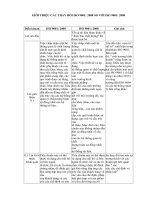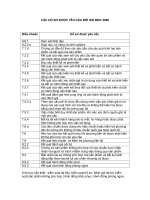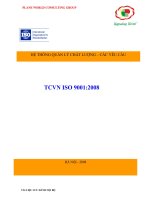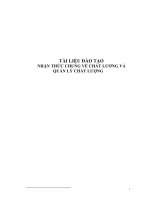ISO 264282:2008 Digital cinema (Dcinema) distribution master — Part 2: Audio characteristics
Bạn đang xem bản rút gọn của tài liệu. Xem và tải ngay bản đầy đủ của tài liệu tại đây (212.31 KB, 8 trang )
INTERNATIONAL ISO
STANDARD 26428-2
First edition
2008-07-15
Digital cinema (D-cinema) distribution
master —
Part 2:
Audio characteristics
Souche de la distribution du cinéma numérique (cinéma D) —
Partie 2: Caractéristiques d'écoute
Reference number
ISO 26428-2:2008(E)
© ISO 2008
ISO 26428-2:2008(E)
PDF disclaimer
This PDF file may contain embedded typefaces. In accordance with Adobe's licensing policy, this file may be printed or viewed but
shall not be edited unless the typefaces which are embedded are licensed to and installed on the computer performing the editing. In
downloading this file, parties accept therein the responsibility of not infringing Adobe's licensing policy. The ISO Central Secretariat
accepts no liability in this area.
Adobe is a trademark of Adobe Systems Incorporated.
Details of the software products used to create this PDF file can be found in the General Info relative to the file; the PDF-creation
parameters were optimized for printing. Every care has been taken to ensure that the file is suitable for use by ISO member bodies. In
the unlikely event that a problem relating to it is found, please inform the Central Secretariat at the address given below.
COPYRIGHT PROTECTED DOCUMENT
© ISO 2008
All rights reserved. Unless otherwise specified, no part of this publication may be reproduced or utilized in any form or by any means,
electronic or mechanical, including photocopying and microfilm, without permission in writing from either ISO at the address below or
ISO's member body in the country of the requester.
ISO copyright office
Case postale 56 • CH-1211 Geneva 20
Tel. + 41 22 749 01 11
Fax + 41 22 749 09 47
Web www.iso.org
Published in Switzerland
ii © ISO 2008 – All rights reserved
ISO 26428-2:2008(E)
Foreword
ISO (the International Organization for Standardization) is a worldwide federation of national standards bodies
(ISO member bodies). The work of preparing International Standards is normally carried out through ISO
technical committees. Each member body interested in a subject for which a technical committee has been
established has the right to be represented on that committee. International organizations, governmental and
non-governmental, in liaison with ISO, also take part in the work. ISO collaborates closely with the
International Electrotechnical Commission (IEC) on all matters of electrotechnical standardization.
International Standards are drafted in accordance with the rules given in the ISO/IEC Directives, Part 2.
The main task of technical committees is to prepare International Standards. Draft International Standards
adopted by the technical committees are circulated to the member bodies for voting. Publication as an
International Standard requires approval by at least 75 % of the member bodies casting a vote.
ISO 26428-2 was prepared by the Society of Motion Picture and Television Engineers (as
SMPTE 428-2-2006) and was adopted, under a special “fast-track procedure”, by Technical Committee
ISO/TC 36, Cinematography, in parallel with its approval by the ISO member bodies.
ISO 26428 consists of the following parts, under the general title Digital cinema (D-cinema) distribution
master:
⎯ Part 1: Image characteristics
⎯ Part 2: Audio characteristics
⎯ Part 3: Audio channel mapping and channel labeling
© ISO 2008 – All rights reserved iii
ISO 26428-2:2008(E)
SMPTE STANDARD SMPTE 428-2-2006
D-Cinema Distribution Master —
Audio Characteristics
Page 1 of 3 pages
Table of contents
Foreword
Introduction
1 Scope
2 Normative references
3 Parameter values
Annex A Bibliography
Foreword
SMPTE (the Society of Motion Picture and Television Engineers) is an internationally-recognized standards
developing organization. Headquartered and incorporated in the United States of America, SMPTE has
members in over 80 countries on six continents. SMPTE’s Engineering Documents, including Standards,
Recommended Practices and Engineering Guidelines, are prepared by SMPTE’s Technology Committees.
Participation in these Committees is open to all with a bona fide interest in their work. SMPTE cooperates
closely with other standards-developing organizations, including ISO, IEC and ITU.
SMPTE Engineering Documents are drafted in accordance with the rules given in Part XIII of its
Administrative Practices.
SMPTE Standard SMPTE 428-2 was prepared by Technology Committee DC28.
Introduction
This standard addresses interoperability of equipment used to deliver audio in digital cinema theaters by
defining the sample rate, bit depth, channel count and reference level of the digital audio.
Copyright © 2006 by THE SOCIETY OF Approved
MOTION PICTURE AND TELEVISION ENGINEERS August 16, 2006
3 Barker Avenue, White Plains, NY 10601
(914) 761-1100 1
© ISO 2008 – All rights reserved
ISO 26428-2:2008(E)
SMPTE 428-2-2006
1 Scope
For interoperability of digital cinema equipment used to create an Audio D-Cinema Distribution Master. The
necessary characteristics of digital audio to be specified are bit depth, sample rate, minimum channel count,
and reference levels.
2 Normative references
The following standard contains provisions which, through reference in this text, constitute provisions of this
standard. At the time of publication, the edition indicated was valid. All standards are subject to revision, and
parties to agreements based on this standard are encouraged to investigate the possibility of applying the
most recent edition of the standard indicated below.
AES3-2003, AES Recommended Practice for Digital Audio Engineering — Serial Transmission Format for
Two-Channel Linearly Represented Digital Audio Data
3 Parameter values
3.1 Bit depth
The bit depth shall be a maximum of 24 bits per sample. Material having other bit depths shall be justified to
the most significant bit (AES3, clause 4.1.1). The audio sample word shall be linear 2’s complement
representation as defined in AES3, clause 4.1.1.
3.2 Sample rate
Irrespective of the associated image frame rate or rates, the delivered audio sample rate contained within the
D-Cinema Distribution Master (DCDM) shall be either forty-eight thousand samples per second per channel,
commonly expressed as 48.000 kHz, or ninety-six thousand samples per second per channel, commonly
expressed as 96.000 kHz. Audio sample rate jitter shall be as specified in AES3.
NOTE – The called out sample rates are an average over time. Instantaneous deviation of the sample rates from their
average (jitter) affects the quality of the audio output in digital-to-analog conversions and so must be considered in
implementation designs.
3.3 Channel count
The digital cinema distribution master (DCDM) shall support a channel count of sixteen full-bandwidth
channels. Not all sixteen channels need be used on any given title.
3.4 Reference level, Digital
Digital inputs and outputs shall have a reference level of –20 dB FS.
Page 2 of 3 pages © ISO 2008 – All rights reserved
2
ISO 26428-2:2008(E)
SMPTE 428-2-2006
Annex A (informative)
Bibliography
AES5-2003, AES Recommended Practice for Professional Digital Audio —Preferred Sampling Frequencies for
Applications Employing Pulse-Code Modulation
AES11-2003, AES Recommended Practice for Digital Audio Engineering — Synchronization of Digital Audio Equipment in
Studio Operations
AES-R2-2004, AES Project Report for Articles on Professional Audio and for Equipment Specifications
© ISO 2008 – All rights reserved Page 3 of 3 pages
3
ISO 26428-2:2008(E)
ICS 35.040; 37.060.99
Price based on 2 pages
© ISO 2008 – All rights reserved









